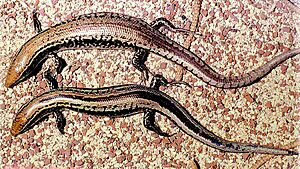Bojer's skink facts for kids
Quick facts for kids Bojer's skink |
|
|---|---|
 |
|
| Conservation status | |
| Scientific classification | |
 |
|
| Approximate distribution
Depicted: Mauritius (Coin de Mire, Round Island, and Ile aux Fouquets), Southern Africa Range Extinct |
|
| Synonyms | |
|
The Bojer's skink (scientific name: Gongylomorphus bojerii) is a small type of lizard. It belongs to the Scincidae family, which are often called "skinks." This special lizard lives only on the island of Mauritius and some smaller islands nearby. This means it is endemic to that area.
Contents
Who is the Bojer's Skink Named After?
The Bojer's skink gets its name from a Czech scientist named Wenceslas Bojer. The scientific name bojerii also honors him.
What Does a Bojer's Skink Look Like?
The Bojer's skink is a small lizard. It grows to be about 11 centimeters (4.3 inches) long. This includes its tail, which is about 6 centimeters (2.4 inches) long. Each of its feet has five toes.
Where Do Bojer's Skinks Live?
Bojer's skinks live in certain parts of the Black River Gorges National Park in Mauritius. They also live on several small islands off the coast of Mauritius. These islands include Ilot Vacoas, Round Island, Serpent Island, Ilot Gabriel, Pigeon Rock, Flat Island, Gunner's Quoin, Ile aux Aigrettes, and Ile de la Passe.
What Kind of Places Do They Like?
Bojer's skinks prefer to live in natural areas. They can be found in grasslands, shrublands, and forests. They live from sea level up to about 280 meters (919 feet) high.
How Do Bojer's Skinks Behave?
Bojer's skinks are active during the day. This means they are diurnal. They also spend most of their time on the ground, so they are terrestrial.
How Are Bojer's Skinks Protected?
The Bojer's skink faces threats, but people are working to help them. One big problem was the Asian house shrew (Suncus murinus). This shrew is an invasive species, meaning it was brought to the area and caused harm to the native animals.
Thanks to the Mauritian Wildlife Foundation, these shrews were removed from the skinks' homes. Also, scientists are helping the skinks by raising them in special centers. They then release them back into the wild. These efforts at the Gerald Durrell Endemic Wildlife Sanctuary are helping the number of Bojer's skinks grow.


